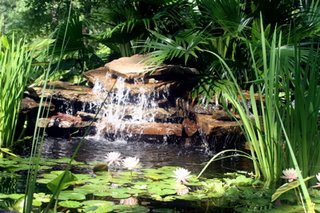Electric costs are easy to compute. I am often asked how much it costs to run a submersible pump and if there is a difference between brands. I will use the example of a 100 watt light bulb and a utility cost of $0.08 per KWH. A KWH is a kilowatt-hour or, 1,000 watts used for 1 hour. A 100 watt light - .1 kilowatt or .1 KWH = less that 1 cent per hour.
• Find the actual wattage used by the motor. (If the actual amp draw is not available, estimate by using the full load amps plate.)
• Watts = volts x amps for single phase motors. The light bulb has an amp draw of 8.7 x 115 volts = 100 watts.
• Compute your cost per month by multiplying the KWH x 24 (hours used per day) x 30 (days used per month) x cost in KWH (to find the actual cost look at your last power bill and divide the total power charges byt KWH used).
Generally mag drive pumps
here
are cheaper to run and of course, solar pumps
here
cost nothing at all.
Time to time musings about backyard garden pond building, keeping, troubleshooting. Questions and answers from pond keepers and builders. Occasional excerpts from the pondlady's book, "A Practical Guide to Building and Maintaining your Pond."
Thursday, October 12, 2006
Wednesday, October 11, 2006
Pond electricity

If you have a
pump
or
lights
in and around your pond, you must connect your cords into a GFI outlet. Some folks call it a GFCI. It is a Ground Fault Interrupter and has the capacity to cut off power instantly if it gets wet. If you are in the water or holding the cord when water comes in contact with electricity, you will realize the GFI was the best thing you had installed. Most construction codes call for them, but oftimes outside outlets do not have them. And in older homes, you won't find them either. If the GFI happens to get wet accidently, you must push the red button on the outlet to reset it. Have your electrician install them whenever water is near. You won't regret it. Water and electricity don't mix. Ever!
Tuesday, October 10, 2006
Cooling down

For the past three days, I have awakened to cooler weather. Don't tell me fall has finally arrived in New Orleans. Now we are forced to do the fall pond tasks we have been putting off. Clean that pump filter; it needs it. Cut back those plants before the water is so cold you can't stand to put your hands in it. Use a net to get the debris out of the bottom. Leaves are turning color now and will fall into the pond in a few days. Put netting or some other cover over the pond to catch them. It's easier than getting them out of the water later.
Here are some great tools to help you get those jobs done
here
Monday, October 09, 2006
A quick fish note
Fish can get sunburned. Don't let that happen by providing shade for them to hide under. It also is cooler in the summer and gives the fish a place to hide when predators arrive.
Sunday, October 08, 2006
Fall color
Here in the South, if we are lucky enough to survive the summers, we can have color in our gardens and around our ponds throughout the fall and winter. I like to use snapdragons and petunias. Pansies are great as well for reliable and exciting color throughout the winter. Don't forget, pansies love blood meal. Put about a teaspoonful in each hole before you put the plant in. If we want to take a chance on no freezes during the winter, and that's a fairly safe bet in these days of global warming, we can take a chance on pentas, impatiens and begonias.
Saturday, October 07, 2006
Overwintering Pond Plants

Here in South Louisiana we don't have to do much to our aquatic plants in the winter. When they start looking ratty, I cut them back to just above the water line. If you live where it freezes, do the same thing. They will return in the spring, happy and healthy. Water lilies are different, of course. If you live up north and have hardy lilies, remove the leaves and make sure the lily does not freeze solid. I would do that by dropping the lily to the very bottom of the pod. It will come back in May or June.
Friday, October 06, 2006
Finding pond leaks

Sometimes liners do get punctured. Raccoons can leave holes behind after their nocturnal dinners out. Sometimes statues fall in the pond and can puncture the liner. Around here Katrina shoved trees through liners, but they were easy to find. Other times, it's just a good old fashioned mystery.
A friend told me that he finds leaks in swimming pools by slowly pouring in fine sand and watching where it goes.
I would definitely try that if you have decided that you have no waterfall leaks, no tubes or connections are leaking, or your skimmer, if you have one, is not leaking at the liner penetration. It is indeed a great idea if you live where you are not below sea level. Pouring food coloring or a bit of milk in will do the same thing.
Here in New Orleans, we are below sea level, so we rarely lose water from a liner leak. If we have a liner puncture, we have to find where the ground water is seeping in, not where pond water is seeping out! Here's how I do it. I empty the pond. Totally. I have been known to take a hair dryer so I could dry the liner completely. Now look around. If there is water coming in, you have found your leak. If you stilll cannot find it, put the garden hose under the liner and turn the water on. Watch until you see water coming up through the liner. Aha, there's the leak.
Leaks are easily patched with a sticky tape that is much like the stuff you use to patch a tire. You can usually find it in big box stores.
Thursday, October 05, 2006
All ponds settle
Probably the biggest problem I ran into while building ponds was water leakage. What pond builders, whether professional or do it yourselfers, fail to realize is that ALL ponds settle. How much depends on where in the world you live. Here in New Orleans I have seen ponds settle as much as 15" over several years because we live in a swamp. When you are building your pond, elevate the sides as much as possible so the inevitable settling does not cause major problems any time soon.
One of the earliest problems with pond settling is water leaking off the back or sides of the waterfall. If your water level drops quickly and for no known reason, turn off your waterfall and fill up your pond. If the water level has not dropped the next morning, you know water is leaking from your waterfall. Usually it is a simple matter to find the miscreant rock and straighten it out. Even if you do have to call someone to move rocks around, you have saved yourself some money by troubleshooting the first part of the problem.
One of the earliest problems with pond settling is water leaking off the back or sides of the waterfall. If your water level drops quickly and for no known reason, turn off your waterfall and fill up your pond. If the water level has not dropped the next morning, you know water is leaking from your waterfall. Usually it is a simple matter to find the miscreant rock and straighten it out. Even if you do have to call someone to move rocks around, you have saved yourself some money by troubleshooting the first part of the problem.
Wednesday, October 04, 2006
Pond color in the fall and winter
 Sunset in Hot Springs, Arkansas.
Sunset in Hot Springs, Arkansas.I am starting to plan my fall garden, while most of you are weeding and mulching, getting ready for a long winter. We rarely have freezes here in New Orleans, so we don't have to plan for that. We just put different plants in the ground.
For you lucky southerners, here's how to put color in your pond in the winter when the water lilies are dormant. Put a painted cinder block in your pond. (I use one painted black so it doesn't show.) Put together a color pot of pansies and snaps or petunias and snaps and put it on top of the cinder block so the bottom of the pot is not or is just a half inch or so in the water. The cinder block should be level with the top of the water or just barely under it. You can leave the pot in the pond or you can change it out to suit you. I put in chrysanthamums now and poinsettias for December. I will do 3 - 5 color pots to make the pond really pop.
Just because the season is drab does not mean the pond has to be.
Monday, October 02, 2006
The Fall Pond
 Sunset in Eureka Springs, Arkansas.
Sunset in Eureka Springs, Arkansas.The pond in autumn is such a beautiful part of the garden. It shows us, even if we live in the South that the seasons are changing, the plants are reacting to longer nights and shorter days. The new water lily leaves are getting smaller and smaller and there are fewer of them. The fish spend more time at the bottom of the pond just floating there getting ready for winter and their long sleep. Everything tells us that the garden wants rest now and aside from cleaning out pond debris, our maintenance is nearly non-existent.
If your pond is under a tree and leaves are falling, you must remove them before winter sets in completely. They will decompose; the toxins will build up under the ice and kill the fish. Some people put a net over the pond to keep the leaves out. Do not throw visqueen over it because that shuts off oxygen to the fish.
Friday, September 08, 2006
A fish out of water
When it is cold outside, we often need to net just one fish out of the water and no matter how hard we try we can't do it. We often end up cold and wet and covered with pond scum because we tried so hard to reach just a little bit farther. Why on earth would we need to know how to get fish out of the pond? Sometimes fish have some sort of disease and treating the entire pond is almost impossible, but treating a few sick fish is economically feasible.
Pour warm water into one end of the pond. The fish will come toward the warm water and right into the net you have conveniently placed there.
Pour warm water into one end of the pond. The fish will come toward the warm water and right into the net you have conveniently placed there.
Thursday, September 07, 2006
Pump use
Question:
I have heard that a pump will keep the water clear. How big should my pump be? Must it run all the time?
Pondlady sez:
A pump will never keep the water clear. A pump moves water and provides oxygen for the fish if you feed them and the pond is overpopulated. If you have a natural ecosystem there will be no overpopulation and therefore you will not need any pump if you don't wish to have one. Most folks like them because we all like the sound of moving water and waterfalls.
You ned a pump that circulates all the water once per hour. Most people run the pump all the time, but it is not necessary at all. You can run the pump on a timer or when you are outside to enjoy your waterfall.
No pump has to be turned on all the time unless you feed your fish or have koi.
And if you live in a climate where you have freezing weather, turn the pump off in the winter. Most pumps do not function well in freezing water. If you are worried about your pond freezing over, throw an empty plastic gallon jug or several in the water during the freezing weather. In the morning, remove the jug and there will be a hole in the ice so gases can move freely during the day. Be sure to put that jug back in the water when the freezing weather returns at night.
I have heard that a pump will keep the water clear. How big should my pump be? Must it run all the time?
Pondlady sez:
A pump will never keep the water clear. A pump moves water and provides oxygen for the fish if you feed them and the pond is overpopulated. If you have a natural ecosystem there will be no overpopulation and therefore you will not need any pump if you don't wish to have one. Most folks like them because we all like the sound of moving water and waterfalls.
You ned a pump that circulates all the water once per hour. Most people run the pump all the time, but it is not necessary at all. You can run the pump on a timer or when you are outside to enjoy your waterfall.
No pump has to be turned on all the time unless you feed your fish or have koi.
And if you live in a climate where you have freezing weather, turn the pump off in the winter. Most pumps do not function well in freezing water. If you are worried about your pond freezing over, throw an empty plastic gallon jug or several in the water during the freezing weather. In the morning, remove the jug and there will be a hole in the ice so gases can move freely during the day. Be sure to put that jug back in the water when the freezing weather returns at night.
Wednesday, September 06, 2006
More aquatic plants
I want to spend more time with submerged plants. They are the engine that makes the pond run properly. After submerged plants, I will talk about floating plants, marginals and emergents.
Submerged aquatics generally grow completely submerged. They are sometimes rooted in the pond bottom and sometimes float freely.

This is the anacharis or elodea we talked about yesterday. It is the most popular and widely used. It is invasive, but not as bad as hydrilla.
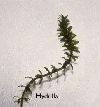 This is hydrilla, another underwater grass.
This is hydrilla, another underwater grass.
They look much alike, but if hydrilla is allowed loose in any fresh water anywhere, it will become a nuisance that will have to be dealt with by governmental authorities. If you see any anywhere for sale, please do not buy it.
Submerged aquatics generally grow completely submerged. They are sometimes rooted in the pond bottom and sometimes float freely.

This is the anacharis or elodea we talked about yesterday. It is the most popular and widely used. It is invasive, but not as bad as hydrilla.
 This is hydrilla, another underwater grass.
This is hydrilla, another underwater grass.They look much alike, but if hydrilla is allowed loose in any fresh water anywhere, it will become a nuisance that will have to be dealt with by governmental authorities. If you see any anywhere for sale, please do not buy it.
Tuesday, September 05, 2006
Anacharis
We talk about needing submerged vegetation in almost every post, so let's see what it looks like:

Elodea canadensis, sometimes called Anacharis (a former scientific name) is widely known as the generic pond submerged vegetation.
In Louisiana we use primarily anacharis for our submerged vegetation. It filters the water, it survives on fish waste and it serves as fish food. Anacharis is the reason we do not need to feed our fish and the reason the water stays clear with no artificial filtration.
Elodea (anacharis) is native to North America and is banned in some states because of it's invasiveness.
The American anacharis lives entirely underwater with the exception of small white flowers which bloom at the surface and and look like somebody threw popcorn all over your pond.
It likes to have some shade and will turn yellow and die when in complete sun.
Please use anacharis responsibly. When you have too much, just compost it, do not throw it in any nearby body of water.

Elodea canadensis, sometimes called Anacharis (a former scientific name) is widely known as the generic pond submerged vegetation.
In Louisiana we use primarily anacharis for our submerged vegetation. It filters the water, it survives on fish waste and it serves as fish food. Anacharis is the reason we do not need to feed our fish and the reason the water stays clear with no artificial filtration.
Elodea (anacharis) is native to North America and is banned in some states because of it's invasiveness.
The American anacharis lives entirely underwater with the exception of small white flowers which bloom at the surface and and look like somebody threw popcorn all over your pond.
It likes to have some shade and will turn yellow and die when in complete sun.
Please use anacharis responsibly. When you have too much, just compost it, do not throw it in any nearby body of water.
Monday, September 04, 2006
Enlarging your pond

One pond regret most people have is they made their first pond too small. So they now want a bigger one.
If you must make the pond bigger, get a new liner. Don't try buying another piece of liner and attaching it to the first piece. You cannot seam a liner successfully in the field. You just can't, so don't get frustrated AND lose money by trying. My method of dealing with the client who wants a larger pond after building the first one is to install a second pond abutting it with a rock wall between the two. I reinforce the walls with 28 or thicker 14” roofing flashing staked up with 1/2” PVC pipe. Doing that insures no collapse of the dividing pond side. Each pond has it’s own pump, it’s own liner, plants, fish etc. Our eyes are fooled because it looks as if there is just a wonderful bridge over the pond when indeed the ‘bridge’ is a divider between two ponds.
Sunday, September 03, 2006
Good morning
Saturday, September 02, 2006
Fish eating critters
Here in New Orleans, lots of critters eat our fish. Raccoons, egrets, herons, cranes all tear through our ponds, eating fish and having a water lily salad with their sushi. As much as we might want to shoot egrets after losing a prize koi or goldfish, it is illegal. It does, however, seem to be perfectly OK to shoot humans and we do it daily, reducing the human population by at least one daily. But I digress.
Years ago, a client of mine was at his wit's end. Egrets were dining daily on his goldfish. This man was a sensible, middle aged guy, a successful and caring OB/GYN who cured, not harmed living things. But he had had it. One day, he got a shotgun and shot at the egrets while they were enjoying dinner. He missed the egrets. But he did manage to puncture his liner, mangle his lawn furniture and his neighbors fence. Luckily he was not caught by the local law enforcers; I don't think they would have understood.
Soon after, I talked him into Gator Guard, a pretty effective way of scaring birds and other critters away.
Years ago, a client of mine was at his wit's end. Egrets were dining daily on his goldfish. This man was a sensible, middle aged guy, a successful and caring OB/GYN who cured, not harmed living things. But he had had it. One day, he got a shotgun and shot at the egrets while they were enjoying dinner. He missed the egrets. But he did manage to puncture his liner, mangle his lawn furniture and his neighbors fence. Luckily he was not caught by the local law enforcers; I don't think they would have understood.
Soon after, I talked him into Gator Guard, a pretty effective way of scaring birds and other critters away.
Friday, September 01, 2006
Bottom rocks
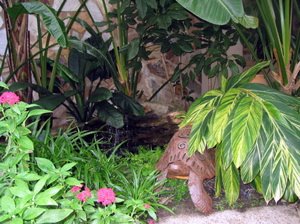
Many folks and one large pond building franchise advocate covering the bottom of the pond with rocks. I think they do this for two reasons. 1) They can charge much more money to build the pond and to clean the pond yearly, and 2) Some really believe that it will help the ecosystem. During my eighteen years of pond building, I never put rocks on pond bottoms, and in all of the ponds I built and maintained, I never, not one time, had green water.
Each and every time I saw a pond bottom covered with rocks, I groaned because I knew that I had to charge the customer much more money to shovel those stones off the bottom to clean the pond. I usually talked them into not replacing them with the promise that next year's cleaning would cost about half as much - because it took half the time and work.
If you think rocks look nice and don't mind the extra cost of cleaning or the extra work of doing it yourself, by all means put them there. But trust me, you do not need them.
Thursday, August 31, 2006
Ponds in the shade
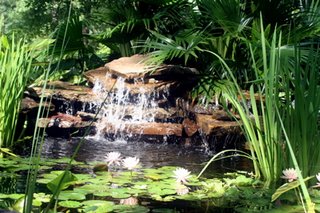
Putting a pond in the shade means you give up water lilies, but you get to plant so many lovely plants around the pond and in the water.
Try Taro (A large elephant ear like plant, but very tropical), or Umbrella plant. I think that it will grow anywhere you put it. As an aside, be very careful if you live in the subtropics, do not plant them close to your house in the ground. I had to break the bad news to a homeowner that the umbrella plant she had lovingly put next to her sunroom had broken the foundation of her house. You may also want to try some indoor plants and take them in during cold weather. Any of the spaths love to have their feet wet and all of the philodrendons.
Some shade tolerating water lilies have been developed. Check your local aquatic nursery for availability and hardiness in your area.
Around the pond you can plant ferns of any and all kinds, gingers and Chinese Fan Palms can back up the waterfall.
Wednesday, August 30, 2006
Leaking liner?
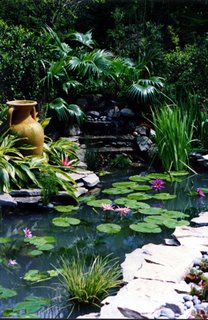
Finding the leak:
Chances are your liner is not leaking at all if you are losing water. Evaporation is usually the cause of slowly lowering water levels. If the water level falls significantly overnight, you are most probably losing it because water is falling off the back of a waterfall or if you have a fountain, the wind has blown the water out of the pond. Or if the water is falling from too far up, it is splashing out. Check all of these things before you suspect a leak in your flexible liner.
If you have finally determined that your liner is leaking, your biggest problem is finding the leak.
Most liners have some sort of patching material, much like patching a tire, but until you find the leak, you cannot patch it. I have found that pumping the water out of the pond and then running water under the liner is the best way to find that ‘unfindable’ leak. Here in New Orleans, the water will come up through the hole when I get water under the liner. I know it is a pain in the neck, but I have yet to find a better way.
At least when you have found the leak, the patching of it is a piece of cake.
Subscribe to:
Posts (Atom)
